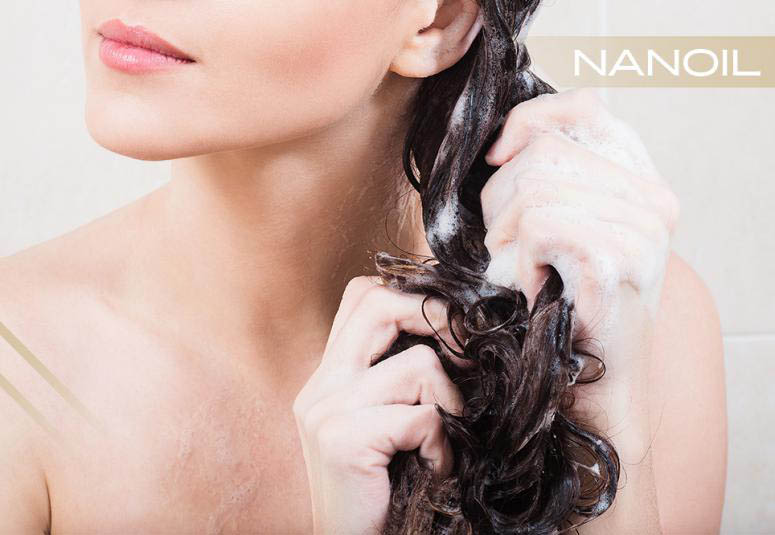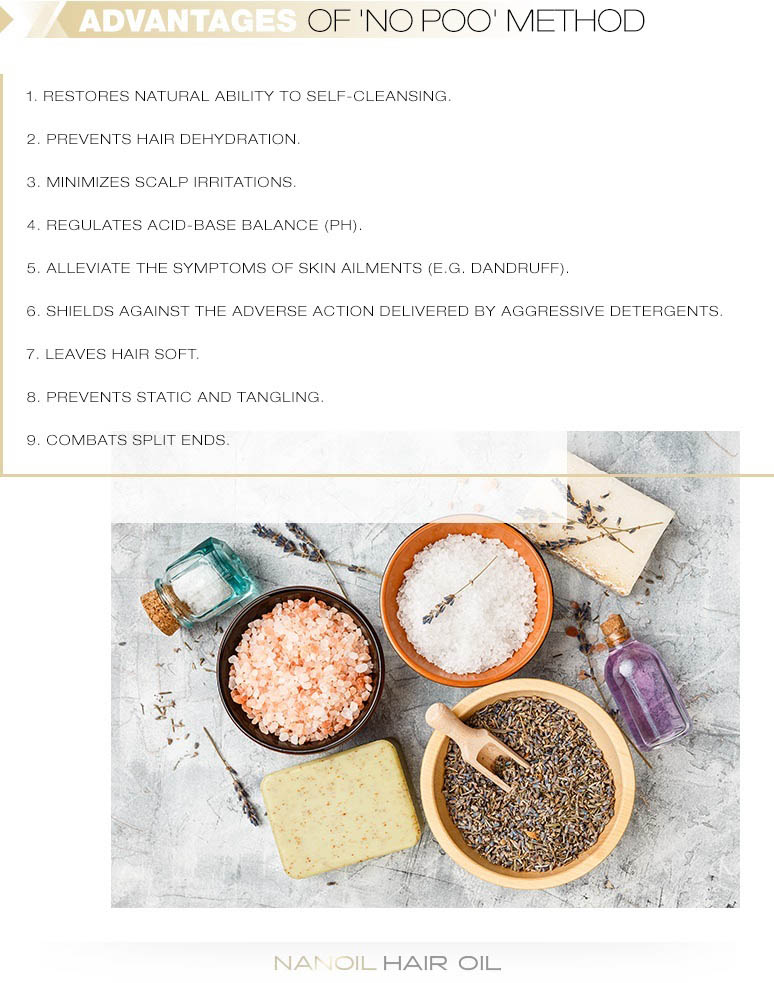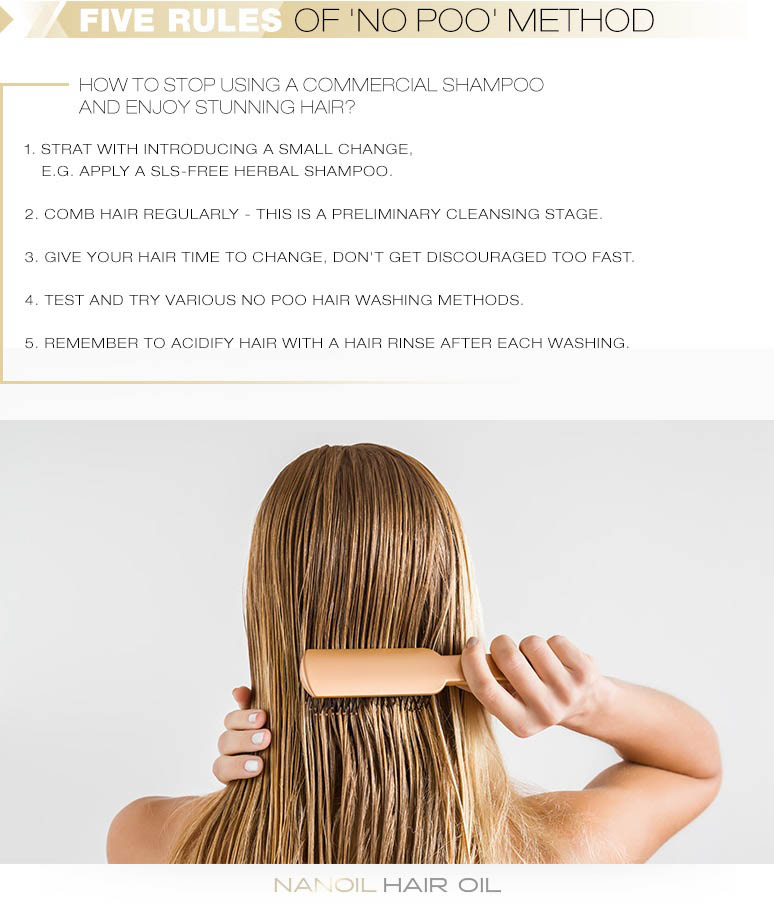- NANOIL Products
- Oils
- Face serums
- Hair masks
- Shampoos
- Hair conditioners
- Hair styling
- Hair Porosity Test
- Blog
- Contact

Fresh-looking hair without a shampoo. Is it even possible? It appears that resigning from a commercial shampoo is easy since there are numerous alternative hair washing methods available. Learn the benefits of cleansing hair due to No Poo method.
Before it happens again that you reach for a hair shampoo unthinkingly or before you start panicking when you notice that you've just run of it, read this article.
More and more often people discuss and question the subject of shampoo use and its harmfulness. After all, in in most cases this hair care product contains aggressively cleansing agents such as SLS (Sodium Lauryl Sulfate) and SLES (Sodium Laureth Sulfate), which are cheap synthetic detergents. They are the substances responsible for effective cleansing. Also, they make a commercial shampoo lather in a pleasant way.
Sadly, this is where the advantages end and where the disadvantages begin because the anionic detergents that synthetic shampoos contain:
- strip scalp from hydro-lipid barrier and dehydrate it
- cause irritations, redness and itchiness
- disturb sebaceous and oily glands
- might disturb acid-base balance of scalp
- lead to development of various skin ailments e.g. dandruff
- can indirectly lead to hair thinning and weakening
Not all hair shampoos are that bad because, after all, you can come across hair cleansing products with good composition featuring gentle washing agents. Still, you can never be too careful, hence No Poo movement. What is it about?
No Poo, which is a catch-phrase deriving from no-shampoo is, as the name speaks for itself, washing hair without using a synthetic shampoo. The main purpose of this method is to limit or considerably reduce the number of harmful detergents in daily hair care. Surprisingly, it isn't that simple - the tricky part about this method is to find reasonable alternatives owing to which no shampoo hair washing will be possible and effective.
Many people believe that there is nothing that might replace a regular shampoo. Still, washing hair by adopting No Poo method is gaining in popularity as the number of people following it is growing. What do they use instead of a shampoo?

Do you know what you can use instead of a commercial shampoo to make your hair clean? This only seemingly limited No Poo method opens many ways of hair care since there are numerous alternatives to regular hair washing. Here are the most popular ones.
Everyone who is acquainted with various methods of hair washing knows that hair can be washed with a conditioner only. This method (also called co-wash) is recommended to those whose hair is dehydrated, damaged or curly - a conditioner contains only gentle detergents which main aim it to leave strands conditioned. At the same time, this product cleans hair without leaving it dry or tangled. Nevertheless, this way of no shampoo hair washing might intensify the problem of greasy scalp. Also, it shouldn't be carried out more often than 2-4 times a week.
Quite an intriguing method is washing hair with oils, which in fact isn't that widespread. Still, it's worth giving this method a go because fatty oils are incredibly good at collecting other fatty impurities and - thanks to this property - cleansing scalp and hair. There is a question rising though, namely, how to remove oil from head? Theoretically, if we use a small amount of a well-absorbing oil (e.g. jojoba, inca inchi or almond), then we don't have to rinse it out since it doesn't leave hair overburdened. However, sometimes you might need to emulsify it with a conditioner.
The most eyebrow-raising No Poo method is using nothing more but just water (a method called 'water only'). Is hair washing without using any cosmetics or natural substances effective? Indeed, back then people used to wash hair in river water and nobody complained about having dandruff, greasy hair or noticing the first signs of baldness. However, today's water is harder and chlorinated, and hair is coated with other types of impurities - toxins, exhaust fumes and excess of seborrhea are hard to remove using only water. Still, you can't be blamed for trying. Surely, washing hair by using only water won't do you any harm, and may enable you to freshen it up, for example, between proper hair washing.
While discussing the subject of No Poo hair washing, we can't forget to mention soap. After all, natural bar soaps might be used not only to clean body but also hair. Which types of bar soaps should a supporter of No Poo method reach for?
A quite controversial method of no shampoo hair washing is cleansing the strands with baking soda. Naturally, this method has as many supporters as opponents. However, it's worth realizing that this homemade shampoo isn't hard to prepare - all you need to do is combine baking soda with water. Now, you can apply the mixture to hair and keep massaging it into scalp for 2-3 minutes. Rinse with lukewarm water. Baking soda is perfect for cleansing, disinfecting and refreshing. Also, it's antibacterial.
NOTE!
Baking soda's pH is base, which might not appear to be beneficial for naturally acidic scalp - hair's pH will be disturbed. For that reason, each hair washing with baking soda should be followed by acidic hair rinse.
While discussing the subject of natural hair washing, there must be a special place provided for various types of brews that might be effectively used as synthetic shampoo alternatives. The thing though is to find plants containing saponins, which is a natural washing compound being released under the influence of warmth. Among others they are wormwood, nettle, calendula, aloe, licorice, fenugreek, comfrey, ivy, St. John's wort, yerba mate (holly genus), ginseng, flax, black cumin and many others.
Of course, you can experiment a little bit or give a try to one of two most popular ideas of washing hair with eco-friendly brews.
Despite the most popular No Poo methods, there are a few dozens of ideas on how to replace a synthetic shampoo. Below you can find the list of the methods that appear the most often on internet forums and in hair care guides.

Converting to natural methods of hair washing is challenging. Although it's not easy to resign from this pleasantly smelling shampoo that gives you the impression of hypercleansiness, it's definitely worth trying to do it. What problems might occur when you decide to wash your hair with No Poo method?
Don't get discouraged! Indeed, the period between resigning from using a synthetic shampoo and restoring the balance to scalp happens to be discouraging but it's definitely worth going through. Washing hair without the use of shampoo is cheaper, more natural and delivers long-term benefits to hair. Give it a go!
Leave your email address and we ll notify you when the product is back in stock.
Comments: #0